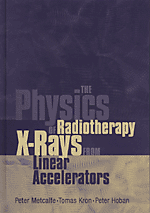
Physics of Radiotherapy X-Rays from Linear Accelerators (softcover)
Author: Peter Metcalfe, Tomas Kron and Peter HobanISBN: 9780944838761 ISBN10: 0944838766
Published: 1997 | 493 pp | Softcover
Price: $ 98.95
Australasian Physical /Engineering | Vol 21, No. 3, 1998
"As the title suggests, this book concentrates on the use of megavoltage x-rays for cancer therapy. It was a pleasure to review a book written by medical physicists resident in Australia. The book contains eight chapters. Chapter 1 covers the basics of how medical linear accelerators work. Chapter 2 contains the mandatory explanation of x-ray and electron interaction including polyenergetic beams and charged particle disequilibrium in the discussion. Chapter 3 is the longest in the book by far (138 pages to be exact) providing an in-depth description of x-ray dosimetry (including phantoms) covering a comprehensive range of detection systems including a number of ‘recent' innovations (i.e. metal oxide semiconductors, diamond detectors, polymer gels and radiochromic film). Clinical x-ray beam characteristics (output factors, B/U doses, depth dose/RPRs, beam profiles, compensators) are discussed [in] Chapter 4 along with radiation shielding for treatment rooms housing linear accelerators and quality assurance. Chapter 5 gives an overview of the proceses associated with planning patient treatments and includes a discussion of some of the more specialised treatment techniques (e.g. TBI, conformal therapy and stereotactic radiosurgery). Chapters 6 & 7 focus on x-ray beam dose calculation algorithms starting with Bentley Milan experimentally based method, the full range of heterogeneity correction models (from effective depth to delta volume & FFT convolution) and finishing with the convolution/superposition and Monte Carlo models. Finally, Chapter 8 introduces the reader to the basics of radiobiology, but mostly focuses [on] radiobiological models such as NSD, the linear quadratic model and a range of other models for normal tissue and tumour response.
"The material is clearly written, there is a wealth of diagrams and other graphics, and the references at the end of each chapter allow the interested reader to pursue a specific topic further. A minor criticism is that some of the graphs with multiple data sets do not have legends. The table of contents is too brief to be useful, the reader must use the index to find topics or ‘flick' through the pages in the appropriate chapter. The chapters are in general logically organised, although the discussion of radiation shielding in Chapter 4 would be better placed in Chapter 1.
"The challenge for this book, which is not a general text in radiotherapy physics (i.e. it does not include the physics of electron beams or brachytherapy), is to provide sufficient detail in its ‘specialised' area without narrowing its potential reader base. The chapter on dosimetry is excellent. The material on convolution/superposition and Monte Carlo dose calculation methods is a timely inclusion given the emergence of the former in commercial planning systems and the current research interest (e.g. the Peregrine project) in using the latter for clinical dosimetry. The chapter on radiobiological models is a welcome reminder (to physicists) that physical dose should not be the sole focus of treatment planning. The material on clinical beam characteristics in Chapter 4 does not include wedges. A discussion on wedges (MU, depth dose & beam profile for internal, external & dynamic wedges) would be useful, in particular, how the profile in the unwedged direction of a wedged field differs from open field profiles. The discussion on ‘calibration field factors' (output factors) is too brief. I also think Chapter 6 would benefit from a detailed description of the algorithms which derive asymmetric off-axis profiles from measured symmetric profile data, e.g. the envelope & boundary profile method proposed by Storchi & Woudstra (Phy. Med. Biol. 40: 511-27, 1995) and a discussion on how profiles in the unwedged dimension of a wedged field can be derived from open field profiles.
"In conclusion, this book is a valuable addition to the existing range of
radiotherapy physics texts and should be purchased by libraries for use by
students studying medical physics and radiotherapy physicists in their early
training years."
Dr. Kym Nitschke
